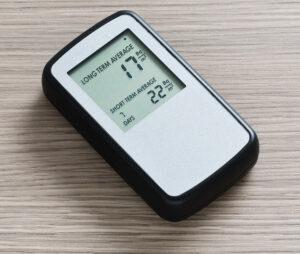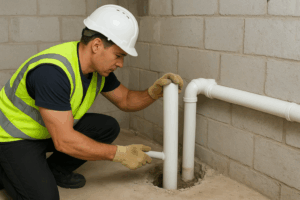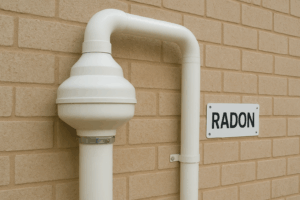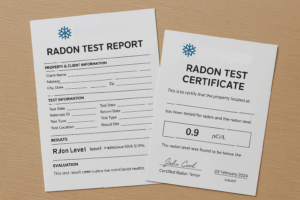Radon Testing & Mitigation
 Why Radon Testing Matters
Why Radon Testing Matters
Radon is a naturally occurring, odourless, colourless radioactive gas that can seep into buildings from the ground. While outdoors it disperses relatively quickly, within enclosed spaces—especially basements or ground-level rooms—it can accumulate to levels that pose a health risk. In the UK, as radon concentration increases, so does the associated risk of lung cancer.
Because radon cannot be seen, smelled or detected without specialised equipment, even seemingly “safe” properties may have elevated levels. The only reliable way to determine your risk is through systematic testing.
Where Radon Comes From & How It Enters Buildings
-
Radon originates from the natural decay of uranium in rocks and soils.
-
It can migrate through cracks in foundations, gaps around pipes, joints, porous floor slabs, or poorly sealed sub-floor voids.
-
Once inside, air pressure differences (e.g. warm interior air drawing in soil gas) can draw radon into occupied spaces.
-
Factors like building age, construction type, ventilation rates, and the local geology affect how much radon can infiltrate a structure.
 Regulatory Framework & Employer Responsibilities
Regulatory Framework & Employer Responsibilities
-
In workplace settings (commercial, industrial, public buildings), employers are required under health & safety regulations to evaluate all hazards to their staff. Radon is included as a potential risk where applicable.
-
If a building lies in a known radon-affected area, or more than 10% of nearby properties show high levels, then radon testing may be considered a legal duty.
-
While there is no blanket law forcing every home to test, for property developers, sellers, and in conveyancing, radon risk assessments are becoming more standard in many areas.
-
For new builds, guidance such as BRE 211 – “Radon: Protective Measures for New Buildings” advises on how to incorporate preventive measures (e.g. membranes, ventilation) into design and construction.
Our Testing Approach
At HVAC, we offer a structured, professional approach to radon measurement tailored to your building’s use, size, and risk profile.
1. Initial Assessment & Quotation
We begin with a site survey and desk-based evaluation:
-
Reviewing local radon maps and geological data
-
Inspecting building plans, foundation details, ground conditions
-
Estimating the number and placement of detectors needed
-
Quoting a customised scope (10-day test, longer-term monitoring, etc.)
2. Detector Deployment & Monitoring
-
We install tamper-resistant detectors (passive or active) in strategic locations (e.g. rooms occupied >4 hours per day, basements, high-risk zones).
-
Monitoring durations may range from 10 days up to 3 months depending on the required accuracy and risk level.
-
For critical sites, we may include “instant sampling” or adaptive monitoring to characterise fluctuations.
3. Data Collection & Analysis
-
After the monitoring period, detectors are retrieved and analysed in a certified lab (ISO 17025 accredited or equivalent).
-
We interpret the results to determine the annual average radon concentration.
-
We issue a clear, documented report with findings, risk levels, and actionable recommendations.
 Mitigation & Remediation (When Elevated Levels Found)
Mitigation & Remediation (When Elevated Levels Found)
If test results exceed acceptable thresholds, we design and implement mitigation systems tailored to your building. Common strategies include:
-
Sub-slab depressurisation (venting radon beneath the floor and discharging it outdoors)
-
Increased ventilation (mechanical extractors, positive input systems)
-
Sealing cracks, service penetrations, and improving the integrity of membranes
-
Incorporating radon-resistant construction features (in new builds or major renovations)
We will provide a full mitigation proposal, including relevant design, installation, verification, and performance testing, to ensure the system effectively reduces radon to safe levels.
Why Choose HVAC for Radon Services?
-
Local presence in Southampton area — fast response to properties in Hampshire, Dorset and surrounding counties
-
Combined expertise in ventilation and HVAC — we understand airflow, pressure control and building systems
-
Use of high-quality, calibrated detectors and reliable analysis
-
Comprehensive project handover: full documentation, certificates, maintenance advice
-
Experience in both residential and commercial settings
 Typical Project Flow
Typical Project Flow
-
Call or email for a preliminary consultation
-
Site evaluation & risk assessment
-
Quotation and agreement
-
Detector deployment & monitoring
-
Lab analysis and reporting
-
If needed, mitigation design
-
Installation, verification and handover
FAQs
What is the “action level” for radon?
In the UK, the reference level is often set around 100 Bq/m³ (becquerels per cubic metre). Below this, the risk is considered low, but above it, mitigation is recommended.
How long does testing take?
Standard tests run for 10 days, but for greater confidence, especially in workplaces or high-risk sites, we often recommend 3 months of monitoring (or a combination of short- and long-term).
Does radon affect all types of buildings?
Yes — radon can affect homes, offices, schools, hospitals, and industrial buildings. The risk is higher where there is a basement, poorly ventilated area, or proximity to radium-rich soils.
Is mitigation expensive?
Costs depend on building size, design, and mitigation complexity. Many homes require only modest works (venting, sealing). Commercial or complex sites may need more involved systems. We’ll always provide transparent cost estimates upfront.
Get Started with a Radon Risk Assessment
If you’d like peace of mind — whether for your home, office, or commercial property — we’d be happy to help. Contact HVAC today to schedule a consultation, get a no-obligation quote, or arrange radon testing in the Southampton area and beyond.
Call us on: 0330 9000 020
Email: info@hvac.co.uk
Or use our contact form
We serve Southampton, Portsmouth, Winchester, Eastleigh, New Forest and surrounding regions.
